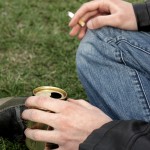
This report from the NHS Information Centre contains results from an annual survey of secondary school pupils in England in years 7 to 11 (mostly aged 11 to 15). 7,296 pupils in 246 schools completed questionnaires in the autumn term of 2010.
The National Centre for Social Research (NatCen) and the National Foundation for Educational Research (NFER) carried out the survey on behalf of The NHS Information Centre for health and social care. The Home Office and The Department for Education also have an interest in the statistics.
This is the most recent survey in a series that began in 1982. Each survey since 1998 has included a core set of questions on smoking, drinking and drug use and, since 2000 the remainder of the questions have focused in alternate years on smoking and drinking or on drug use. The emphasis of the 2010 survey is on smoking and drinking whilst still containing some information on drug use.
The survey report presents information on the percentage of pupils who have ever smoked, tried alcohol or taken drugs. The report also explores the attitudes and beliefs of school children towards smoking and drinking and from where and from whom children obtain cigarettes and alcohol. Relationships between smoking, drinking and drug use are explored along with the links between smoking, drinking and drug use and other factors such as age, gender, ethnicity and previous truancy or exclusion.
Key facts from the report:
- In 2010, 27 per cent of pupils had smoked at least once, compared with 44 per cent in 2001. In 2010, 5 per cent of pupils smoked regularly. As in previous years, girls were more likely than boys to be regular smokers (6 per cent and 4 per cent respectively).
- 45 per cent of pupils said that they had drunk alcohol at least once in 2010. This continues the downward trend since 2003, when 61 per cent of pupils had drunk alcohol, and is markedly lower than the equivalent percentage in 2009, which was 51 per cent. Future data will establish how these fit into the longer term trend.
- Pupils are most likely to think that people of their age drink to look cool in front of their friends (76 per cent), to be more sociable with friends (65 per cent), because their friends pressured them into it (62 per cent) or because it gives them a rush or buzz (60 per cent). However there was a clear contrast in responses between pupils who drink and those who do not drink. The most popular reasons for pupils who had drunk alcohol in the last week were for the rush or buzz or to be more sociable. However non-drinkers thought their peers drank alcohol to look cool in front of friends or because of pressure from their friends.
- In 2010, 18 per cent of pupils reported ever having taken drugs and 12 per cent of pupils had taken drugs in the last year. This is a decrease from 29 per cent and 20 per cent respectively in 2001. As in previous years, pupils were most likely to have taken cannabis (8.2 per cent) than any other drug in the last year (13.4 per cent in 2001).
- 55 per cent of pupils thought it was acceptable for someone their age to try drinking to see what it was like, 35 per cent thought it was acceptable to try smoking and fewer than 10 per cent of pupils thought that it was acceptable to try specific drugs (e.g. cannabis, sniffing glue, and cocaine).
Smoking, drinking and drug use among young people in England in 2010 – full report (PDF). NHS Information Centre, 28th Jul 2011.
